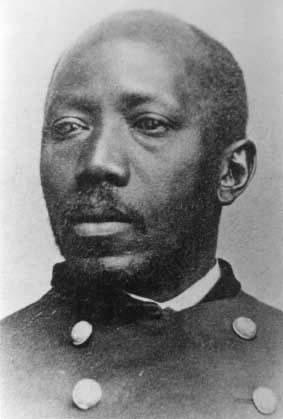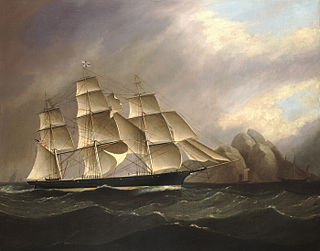Mendi was a barque. Like most ships serving Liberia, it was black-owned, in this case by J. D. Johnson, Turpin, and Dunbar. [1] Available documentation shows that at least between 1856 [2] and 1859, it sailed regularly, carrying Black passengers and exported goods, between New York and Monrovia, Liberia. [3] In a sailing of 1856 the ship carried 6 cabin passengers, including two ministers and two medical students, and 5 steerage passengers. [2]
A distinguished passenger was Martin Delany, who on May 24, 1859, sailed from New York on Mendi, seeking to explore the Niger River. Accompanying him as far as Monrovia, Liberia, was Reverend William C. Munroe. [3] Munroe had been with Delany at John Brown's 1858 planning conference in Chatham, Ontario; in fact he was elected its president. [4]

Joseph Jenkins Roberts was an Americo-Liberian merchant who emigrated to Liberia in 1829, where he became a politician. Elected as the first (1848–1856) and seventh (1872–1876) president of Liberia after independence, he was the first man of African descent to govern the country, serving previously as governor from 1841 to 1848. He later returned to office following the 1871 Liberian coup d'état. Born free in Norfolk, Virginia, Roberts emigrated as a young man with his mother, siblings, wife, and child to the young West African colony. He opened a trading firm in Monrovia and later engaged in politics.

Donald McKay was a British North America-born American designer and builder of sailing ships, famed for his record-setting extreme clippers.

Martin Robison Delany was an American abolitionist, journalist, physician, military officer and writer who was arguably the first proponent of black nationalism. Delany is credited with the Pan-African slogan of "Africa for Africans." Born as a free person of color in Charles Town, Virginia, now West Virginia, and raised in Chambersburg and Pittsburgh, Pennsylvania, Delany trained as a physician's assistant. During the cholera epidemics of 1833 and 1854 in Pittsburgh, Delany treated patients, even though many doctors and residents fled the city out of fear of contamination. In this period, people did not know how the disease was transmitted.

USS Saratoga, a sloop-of-war, was the third ship of the United States Navy to be named for the Battle of Saratoga of the American Revolutionary War. Her keel was laid down in the summer of 1841 by the Portsmouth Navy Yard. She was launched on 26 July 1842 and commissioned on 4 January 1843 with Commander Josiah Tattnall III in command.

The first USS Supply was a ship-rigged sailing vessel which served as a stores ship in the United States Navy. She saw service in the Mexican–American War and the American Civil War.

Marco Polo was a three-masted wooden clipper ship, launched in 1851 at Saint John, New Brunswick. She was named after Venetian traveler Marco Polo. The ship carried emigrants and passengers to Australia and was the first vessel to make the round trip from Liverpool in under six months. Later in her career, the ship was used as a cargo ship before running aground off Cavendish, Prince Edward Island, in 1883.

The second USS Niagara was a screw frigate in the United States Navy.

Roberts International Airport, informally also known as Robertsfield, is an international airport in the West African nation of Liberia. Located near the town of Harbel in Margibi County, the single runway airport is about 35 miles (56 km) outside of the nation's capital of Monrovia, and as an origin and destination point is referred to as "Monrovia". Locally, it is often referred to as simply "RIA." The airport is named in honor of Joseph Jenkins Roberts, the first President of Liberia.

The America class was the replacement for the Britannia class, the Cunard Line's initial fleet of wooden paddle steamers. Entering service starting in 1848, these six vessels permitted Cunard to double its schedule to weekly departures from Liverpool, with alternating sailings to New York. The new ships were also designed to meet new competition from the United States.
Farrell Lines Incorporated was a boat company named in 1948 after James A. Farrell, Jr., and John J. Farrell, sons of James Augustine Farrell, president of US Steel. The company was previously known as American South African Lines (ASAL). It was a passenger line and cargo line in regular service from New York City to South Africa stopping at Cape Town, Port Elizabeth, Durban and Lourenço Marques (Maputo) in Mozambique. The ships were well-appointed and carried about 180 passengers.

Ocean Telegraph was a clipper ship that was built in Massachusetts in 1854 and was last known of in Gibraltar in 1923. She was in US ownership until 1863, when UK interests bought her and renamed her Light Brigade.

Comet was an 1851 California clipper built by William H. Webb which sailed in the Australia trade and the tea trade. This extreme clipper was very fast. She had record passages on two different routes: New York City to San Francisco, and Liverpool to Hong Kong, and beat the famous clipper Flying Dutchman in an 1853 race around the Horn to San Francisco.
Daniel Laing Jr. was a doctor in the United States and Liberia. He was one of the first African-American physicians in the United States.

African Slave Trade Patrol was part of the Blockade of Africa suppressing the Atlantic slave trade between 1819 and the beginning of the American Civil War in 1861. Due to the abolitionist movement in the United States, a squadron of U.S. Navy warships and Cutters were assigned to catch slave traders in and around Africa. In 42 years about 100 suspected slave ships were captured.
Hooghly was a full-rigged merchant ship built on the Thames, England, and launched in 1819. She made two voyages under charter to the British East India Company (EIC), four voyages transporting convicts from England and Ireland to Australia, as well as voyages transporting emigrants to South Australia between 1839 and 1856. Around 1858 she was re-rigged as a barque. She sank off Algiers in 1863.

Americo-Liberian people, are a Liberian ethnic group of African American, Afro-Caribbean, and liberated Africans. Americo-Liberians trace their ancestry to free-born and formerly enslaved African Americans who emigrated in the 19th century to become the founders of the state of Liberia. They identified themselves as Americo-Liberians.
The Pomona was a fast packet clipper ship constructed in 1856 for Howland and Frothingham. She operated for just over two and a half years transporting emigrants and cargo from Liverpool, England to New York City. Pomona sank in the early morning of April 28, 1859 after a navigation error caused the ship to strike the Irish coast. 424 of the 448 people on board died.

Donald McKay was an extreme clipper designed by Donald McKay, his last. Built for James Baines & Co., she sailed on the Black Ball Line of Liverpool from 1855 to 1868, carrying passengers and mail between England and Australia.

The Coquette was a 19th-century yacht and pilot boat, built in 1845 by Louis Winde, at the Winde & Clinkard shipyard in Chelsea, Massachusetts for yachtsmen James A. Perkins. Her design was based on a model by shipbuilder Dennison J. Lawlor. The Coquette was a good example of an early American yacht with a clipper bow. As a yacht, she won the attention for outsailing the larger New York yacht Maria at the second New York Yacht Club regatta in 1846. Perkins sold the Coquette to the Boston Pilots' Association for pilot service in 1848. She continued as a pilot boat until 1867 when she was sold as a Blackbirder to be used on the African coast.
 ]
]













